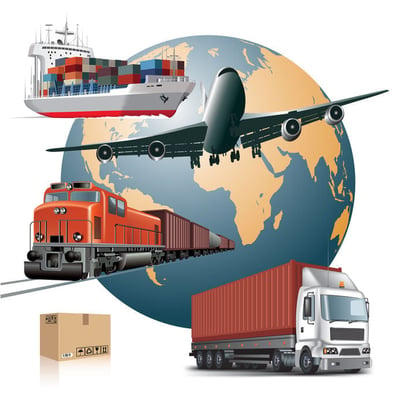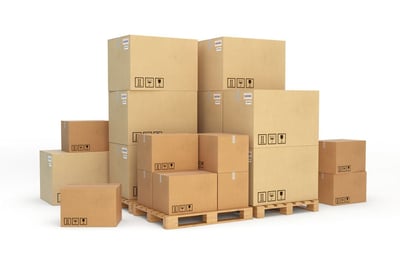Logistics 101: Freight
International shipping and freight is a complicated business. When moving goods over land, sea, and air, there are a lot of moving pieces and a lot of industry-specific terminology that can be confusing. We’ve put together a brief introductory guide to help you navigate the real basics of freight.
Freight vs. cargo vs. shipping
Freight
The word “freight” is used in several contexts and can be either a noun or verb depending on how it's used:
- When a volume of goods is transported by truck or by train (hence the term freight train). (Verb.)
- To refer to the payment of the goods that are transported. (Noun.)
- Freight can also mean a shipment being transported via truck, train, plane, and ship. (Noun.)
Freight can refer to many things. Freight may refer to the product, merchandise, amount payable, or money charged. Most cargo being transported can be referred to as freight.
Cargo
“Cargo,” on the other hand, is usually used when the goods are transported via plane or ship (think: cargo planes). Cargo refers specifically to goods only—so any product being transported is always called a cargo.
Shipping
Shipping refers to the transport of goods by water, land, or air. This can be either commercial or non-commercial shipments, and can include freight shipments and parcel shipments. Although “freight” can be used in varying ways, “shipping” is simply the process of moving product from origin to destination.
Containers, unit load devices, and trailers
Depending on which mode of transport your goods are traveling by (air, land, or sea) the device used to house your goods has a different name.
Sea: containers
Goods traveling by sea are housed in ocean freight containers, referred to as either containers or sea-cans. Most containers are large rectangular receptacles made of steel, with corrugated sides, and the bottoms are usually made of wood planks or plywood.
Air: ULDs
Freight traveling by air is loaded into a unit load device (ULD). ULDs come in two forms: pallets and containers (also known as cans or pods). Depending on the nature of the goods to be transported, these may have built-in refrigeration units.
Land: trailers and freight cars
Goods traveling over land in trucks are loaded onto trailers, such as flatbed trailers, dry vans, refrigerated trailers, or other styles of trailers designed to accommodate loads that are, for example, particularly tall or long. Goods traveling by train are loaded onto freight cars or goods wagons.
Pallets, crates, and skids
Pallets, crates, and skids are typically used for:
- Ease of handling
- Packaging
- Maximizing space
Pallet
A pallet is an extremely popular way of shipping and storing freight. With both a top and bottom deck, pallets are easily moved, loaded and unloaded by forklift. They are stable, easy to stack and very mobile. Goods can be secured with strapping, stretch or shrink wrap.
Skid
The skid is similar to a pallet, except it lacks the bottom deck. It uses less material and is often cheaper than a pallet. They are not as simple to move with a forklift, but take up less space than pallets and can be stored easily.
Crate
A crate is essentially a box. It offers your freight far more protection than pallets or skids. They can be built to fit any type of goods and can hold a huge volume of freight. Crates are ideal for stacking, but can be bulky and slightly more challenging to transport.
FCL, FTL, LCL, LTL
Full Container or Trailer Load (FCL or FTL)
FCL and FTL refers to a shipment that fills an entire container or trailer. Full containers and trailers tend to incur lower freight charges than other options.
Partial truckload
These are shipments that don’t completely fill a truck, but tend to remain on a single truck similar to full truckload shipments. The core difference between LTL and Partial TL is the way it is transported rather than its size or weight.
Less Than Container or Trailer Load (LCL or LTL)
If your freight doesn’t fit an entire container or trailer, LCL or LTL shipping allows you to pay only for the volume of your goods. Carriers will load several LCL/LTL shipments into a single ship or truck to serve multiple customers and destinations.
Shipping and freight rates
Rates are determined by a variety of factors. Read our recent article on shipping and freight rates.
Freight forwarding
While many companies prefer to work directly with transport carriers, read more about:
International shipping can be complex. With offices in the U.S. and Canada, and over half a century of experience, our logistics professionals can take the stress out of international shipping. Freight forwarding: It’s what we do.
Learn more about our Freight Forwarding Services.

Latest Articles
- Watch out for these extra charges on your freight bill
- Key differences between duty drawbacks and duty refunds for importers
- Mitigating container shortages and rising shipping prices for ocean imports
- How Canadian importers benefit from end use tariff codes and conditional relief
- The benefits of operating as a Non-Resident Importer in Canada

